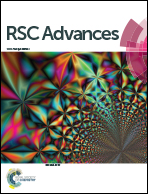Electronic structure, low-temperature transport and thermodynamic properties of polymorphic β-As2Te3†
Abstract
β-As2Te3 belongs to the prominent family of Bi2Te3-based materials, which show excellent thermoelectric properties near room temperature. In this study, we report a joint theoretical and experimental investigation of its electronic and thermal properties at low temperatures (5–300 K). These results are complemented by specific heat measurements (1.8–300 K) that provide further experimental evidence of the first order lattice distortion undergone by β-As2Te3 near 190 K. Data taken on cooling and heating across this transition show that the lattice distortion has little influence on the electronic properties and further evidence a weak hysteretic behavior. Although first-principles calculations predict a semiconducting ground state, these measurements show that β-As2Te3 behaves as a degenerate p-type semiconductor with a high carrier concentration of 1020 cm−3 at 300 K likely due to intrinsic defects. Calculations of the vibrational properties indicate that the extremely low lattice thermal conductivity values (0.8 W m−1 K−1 at 300 K) mainly originate from low-energy Te optical modes that limit the energy window of the acoustic branches. This limited ability to transport heat combined with a relatively large band gap suggest that high thermoelectric efficiency could be achieved in this compound when appropriately doped.


 Please wait while we load your content...
Please wait while we load your content...